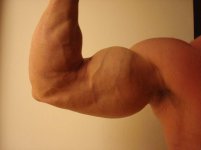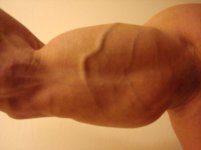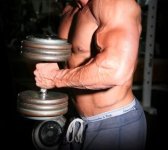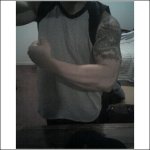Medicine & Science in Sports & Exercise:Volume 32(1)January 2000p 235
Single versus multiple sets in long-term recreational weightlifters
[SPECIAL COMMUNICATIONS: Methods]
Abstract TOP
HASS, C. J., L. GARZARELLA, D. DE HOYOS, and M. L. POLLOCK. . Med. Sci. Sports Exerc., Vol. 32, No. 1, pp. 235-242, 2000.
Purpose: The purpose of this study was to determine the effects of increasing training volume from one set to three sets on muscular strength, muscular endurance, and body composition in adult recreational weight lifters.
Methods: Forty-two adults (age 39.7 ± 6.2 yr; 6.2 ± 4.6 yr weight training experience) who had been performing one set using a nine-exercise resistance training circuit (RTC) for a minimum of 1 yr participated in this study. Subjects continued to perform one set (EX-1;N = 21) or performed three sets (EX-3;N = 21) of 8-12 repetitions to muscular failure 3 d·wk-1 for 13 wk using RTC. One repetition maximums (1-RM) were measured for leg extension (LE), leg curl (LC), chest press (CP), overhead press (OP), and biceps curl (BC). Muscular endurance was evaluated for the CP and LE as the number of repetitions to failure using 75% of pretraining 1-RM. Body composition was estimated using the sum of seven skinfold measures.
Results: Both groups significantly improved muscular endurance and 1 RM strength (EX-1 by: 13.6% LE; 9.2% LC; 11.9% CP; 8.7% OP; 8.3% BC; and EX-3 by: 12.8% LE; 12.0% LC; 13.5% CP; 12.4% OP; 10.3% BC) (P < 0.05). Both groups significantly improved lean body mass (P < 0.05). No significant differences between groups were found for any of the test variables (P > 0.05).
Conclusion: Both groups significantly improved muscular fitness and body composition as a result of the 13 wk of training. The results show that one-set programs are still effective even after a year of training and that increasing training volume over 13 wk does not lead to significantly greater improvements in fitness for adult recreational weight lifters.
Resistance training has become one of the most popular forms of exercise for developing musculoskeletal fitness and overall health (9). Musculoskeletal fitness decreases the risk for orthopedic injury and delays the onset of frailty associated with aging (8,18). Resistance training reduces the risk of coronary heart disease (CHD), osteoporosis, and non-insulin-dependent diabetes and lowers the risk for obesity by elevating resting metabolism when part of a comprehensive exercise program (6,9,21). The physiological adaptations resulting from a well-designed resistance training program include increased strength, muscle hypertrophy, lean body mass, bone mass, connective tissue thickness, and improved physical function (27,28,30).
The beneficial effects conferred by resistance training depend on the manipulation of several factors, including the intensity and frequency of training, and the volume of exercise needed to meet the goals of the individual (9). The volume of exercise is a product of the number of sets completed of each exercise and the number of repetitions completed in each set. For adults interested in general health and fitness, the American College of Sports Medicine and the Surgeon General recommend a weight training regimen that requires a minimum of a single set per exercise for 8-12 repetitions (1,31). These recommendations are based on the time efficiency of single-set programs and the similar improvements in strength observed when comparing single and nonperiodized multiple-set programs (1).
However, Fleck and Kraemer (9) suggest that the use of single-set programs are most appropriate for individuals who are untrained or are just starting a resistance training program. These authors suggest that once initial fitness has been achieved, multiple sets become superior to a single set in acquiring optimal physiological adaptation. Presumably, the proposed greater improvements in performance conferred by multiple-set programs would surpass the time advantages of one-set training. There are few published studies examining the effects of training volume on muscular hypertrophy and strength in previously resistance trained adults. Kramer et al. (16) examined the effects of a single set of weight training exercise to failure and two multiple-set protocols (three sets of 10 repetitions (MS) and a multiple-sets program using varied set and repetition schemes (MSV)) on the 1-RM parallel squat in recreational weight lifters. The results indicated that the 1-RM parallel squat increased significantly in all groups and that the MS and the MSV increased strength significantly more than the single-set group. Conversely, Ostrowski et al. (19) reported that one set per exercise was as effective as two sets and four sets for improving muscular size, strength, and upper body power in recreational weight lifters during a 10-wk total body training program.
Apparently, the optimal volume of resistance training for recreational weight lifters is undetermined. Further, the efficacy of one-set programs have not been evaluated in long-term lifters. The purpose of this study was to determine whether increasing training volume (from one to three sets) would elicit greater improvements in muscular strength, muscular endurance, and body composition in recreational weight lifters. We hypothesized that both weight trained groups would show similar improvements in muscular strength, endurance, and body composition. Further, it was hypothesized that no additional improvements would occur with the higher volume of training.
METHODS TOP
Subjects recruited for this study were between the ages of 20 and 50 yr and were active members of Gainesville Health and Fitness Center (GHFC), in Gainesville, Florida. They were apparently healthy volunteers with no history of cardiovascular disease, orthopedic problems, or other medical conditions that would contraindicate exercise. All subjects were recreational weight lifters with an average of 6.2 ± 4.6 yr resistance training experience who had been performing one set of the nine exercise circuit for an average of 2.7 times a week for a minimum of 1 yr. The training goals of these individuals were improved health and muscular fitness. Descriptive characteristics of the subjects are presented by group in Table 1.


































.gif)














































